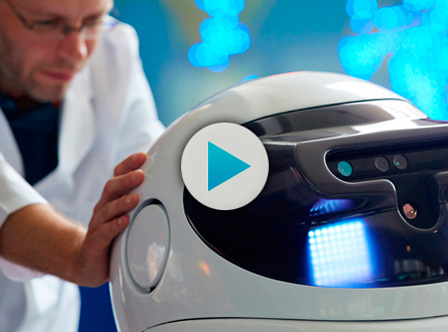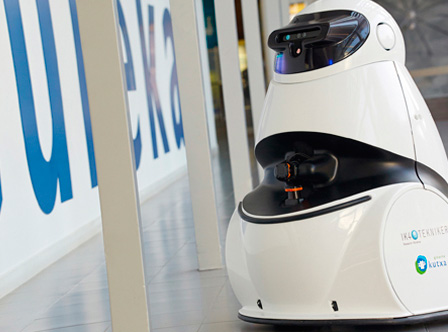PROJECTS
kTBot can navigate autonomously, carries out guide duties for the visitors, presents the content in the various rooms, and works as an assistant at events.
Robotics has been around for years in many sectors of industry, but this discipline is only now exploiting the huge possibilities that are opening up for it in the services sector. Robots are starting to move out of the factories and enter hospitals, care homes and even private homes. Robotics applications are gradually expanding with new robot assistants that collaborate with operatives in different industrial and services ambits, or with innovative concepts like robots geared towards specialised tasks including maintenance, cleaning, surveillance and security, transport, etc.
In this context, Basque robotics has just taken a great leap forward with the presentation at the Eureka! Science Museum in San Sebastian of the kTBot robot, which will act as a museum guide, among other things. ktBot was produced by IK4-TEKNIKER and financed by the Kutxa Savings Bank’s Benevolent Fund.
Its duties will be to provide support in the activities that are organised in the museum through different ways of working. The first will be to act as a guide for the visitors: kTBot will be accompanying groups to the rooms they want to visit. Along the way the robot will approach the visitors and offer to be their guide and will turn the route into a pleasurable experience by offering scientific news and messages relating to the museum's content. kTBot has been set up to navigate by dodging obstacles in spaces full of people.
The robot’s second way of working is to present the content of the various rooms at the Eureka! Museum to the visitors by following a pre-established route. In each of the rooms the robot will offer a brief explanation of what the visitors can see. The kTBot will then direct the visitors to the next room along the route.
As the museum regularly hosts events like talks, workshops, conferences or presentations, the robot will also be fulfilling the duties of assistant in these events. In other words, it will be offering assistance in tasks like receiving the attendees and accompanying them, and announcing the activities scheduled.
At the cutting edge of robotics
The challenge facing the IK4-TEKNIKER team was to create a robot capable of integrating into environments that were not specially adapted to it and which were continually changing and had a considerable human presence. What is more, the robot they have built is capable of interacting with people thanks to various sensory systems.
So kTBot has been equipped with the capacity to navigate autonomously. In other words, with the capability of planning and executing routes, while avoiding obstacles and detecting people around it. Equipped with a whole range of sensors, it has an attractive, friendly shape, lit up by various LEDs that enable it to display easy-to-understand messages in a straight forward way.
IK4-TEKNIKER is working actively to develop technology to address the current challenges of robotics and has broad experience in the development of robotised solutions in the field of industrial robotics as well as services robotics. Right now, the centre is working on 5 European projects in the field of robotics and, on behalf of the IK4 Research Alliance, is a founder member of the steering committee of euRobotics aisbl, the body that advises the European Commission in robotics research.
IK4-TEKNIKER’s mission is to develop and transfer technology that can improve the competitiveness of companies. One of the centre's strategic commitments is that relating to robotic technologies, which can clearly contribute in this respect and which will allow IK4-TEKNIKER to be at the forefront in the next robotics generation, characterised by new applications and services in fields in which it has currently penetrated little. This new generation of robots will be characterised by a significant role in aspects like security, close collaboration between robots and people, and the introduction of innovative mechatronic developments.





